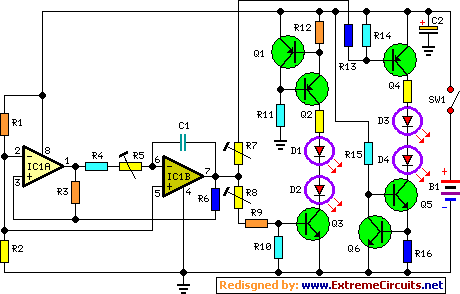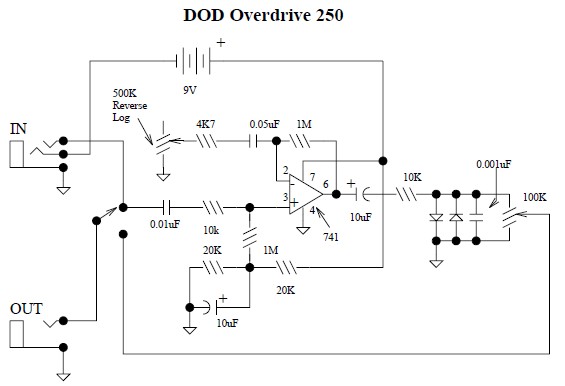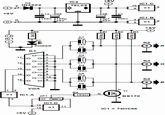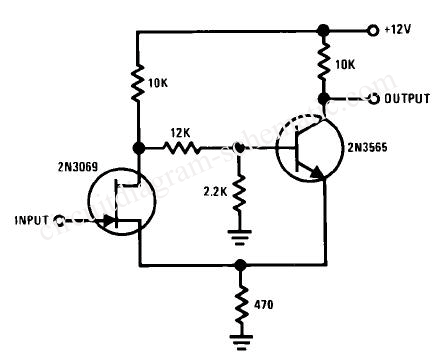
British Police Car Siren circuit diagram
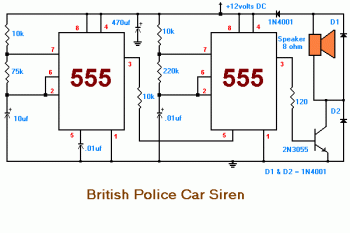
The 555 timer on the right is configured as an alarm sound generator, while the second 555 timer on the left functions as a 1 Hz astable multivibrator. The output from the left timer modulates the frequency of the right timer, resulting in the right timer's frequency alternating between 440 Hz and 550 Hz at a cyclic rate of 1 Hz. The transistor 2N3055 is utilized to amplify the sound signal to the loudspeaker. This circuit is suitable for novice hobbyists.
The circuit utilizes two 555 timer integrated circuits (ICs) to create a sound-generating alarm system. The first timer, configured as an astable multivibrator, operates at a frequency of 1 Hz. This timer continuously switches its output between high and low states, generating a square wave signal. The output of this timer is connected to the control pin of the second 555 timer, which is set up as a frequency generator for sound output.
The second 555 timer alternates its output frequency between 440 Hz (the musical note A4) and 550 Hz, producing a modulated sound that can be perceived as a beeping or alarm sound. The modulation is achieved by using the low-frequency output from the first timer to influence the timing components of the second timer, effectively changing its frequency in a cyclic manner.
To amplify the sound produced by the second timer, a 2N3055 transistor is employed. This NPN power transistor is capable of handling higher currents, making it suitable for driving a loudspeaker. The output from the second timer is fed into the base of the 2N3055, allowing it to control a larger current flowing from the power supply to the loudspeaker.
The circuit is designed with simplicity in mind, making it an excellent project for beginner hobbyists interested in learning about timer circuits and sound generation. The use of widely available components and the straightforward nature of the design facilitate easy assembly and troubleshooting.The 555 on the right is wired as an alarm sound generator and the second 555 timer on the left is a 1 Hz astable multivibrator. The output of the left timer is to modulate the frequency of the right timer. This process will cause the right timers frequency to alternate between 440Hz and 550Hz at a 1 Hz cyclic rate.
The transistor 2N3055 is used to amplify the sound signal to the loudspeaker. This circuit should be nice for newbie hobbysts. We aim to transmit more information by carrying articles. Please send us an E-mail to wanghuali@hqew. net within 15 days if we are involved in the problems of article content, copyright or other problems. We will delete it soon. 🔗 External reference
The circuit utilizes two 555 timer integrated circuits (ICs) to create a sound-generating alarm system. The first timer, configured as an astable multivibrator, operates at a frequency of 1 Hz. This timer continuously switches its output between high and low states, generating a square wave signal. The output of this timer is connected to the control pin of the second 555 timer, which is set up as a frequency generator for sound output.
The second 555 timer alternates its output frequency between 440 Hz (the musical note A4) and 550 Hz, producing a modulated sound that can be perceived as a beeping or alarm sound. The modulation is achieved by using the low-frequency output from the first timer to influence the timing components of the second timer, effectively changing its frequency in a cyclic manner.
To amplify the sound produced by the second timer, a 2N3055 transistor is employed. This NPN power transistor is capable of handling higher currents, making it suitable for driving a loudspeaker. The output from the second timer is fed into the base of the 2N3055, allowing it to control a larger current flowing from the power supply to the loudspeaker.
The circuit is designed with simplicity in mind, making it an excellent project for beginner hobbyists interested in learning about timer circuits and sound generation. The use of widely available components and the straightforward nature of the design facilitate easy assembly and troubleshooting.The 555 on the right is wired as an alarm sound generator and the second 555 timer on the left is a 1 Hz astable multivibrator. The output of the left timer is to modulate the frequency of the right timer. This process will cause the right timers frequency to alternate between 440Hz and 550Hz at a 1 Hz cyclic rate.
The transistor 2N3055 is used to amplify the sound signal to the loudspeaker. This circuit should be nice for newbie hobbysts. We aim to transmit more information by carrying articles. Please send us an E-mail to wanghuali@hqew. net within 15 days if we are involved in the problems of article content, copyright or other problems. We will delete it soon. 🔗 External reference
